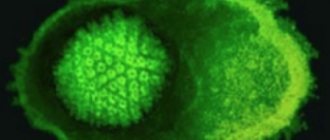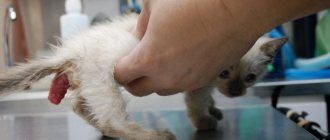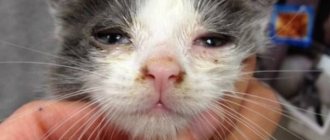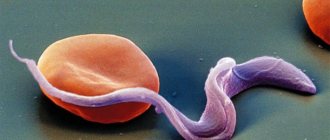9831Pavel
Despite the increased cleanliness of cats, they are not immune from various diseases, including the most dangerous ones, which can cost them their lives if incorrectly diagnosed and treated. One of these diseases is panleukopenia or feline distemper, another name for viral enteritis. Every owner of a furry pet should know the symptoms and treatment of panleukopenia in cats, only this will save the cat from unnecessary suffering and torment. Timely prevention of the disease is better than treatment.
What causes panleukopenia
The causative agent of panleukopenia is parvovirus (FPV, feline parvovirus, feline panleukopenia virus).
Parvoviruses are a family of small DNA viruses. Currently, the family includes 56 viruses that infect invertebrates and vertebrates.
Parvovirus consists of a small piece of DNA surrounded by a protein coat.
Basically, parvoviruses are species-specific, that is, for example, a virus that infects pigs is not dangerous for dogs. However, there are exceptions to every rule.
The causative agent of the disease
It is worth noting that the causative agent of distemper in cats retains its viability in the external environment for a long time. In addition, it is from the same family as the canine distemper virus (canine distemper) – Parvoviridae. And just like the canine distemper virus, the panleukopenia virus in cats prefers intestinal cells. However, the most favorite “place” is lymphoid tissue. And due to the fact that it is affected by a virus (when the virus settles in a cell, it “kills” it), leukocytes stop being produced. The old ones die off, there are no new ones. This is the “death” of immunity. And that’s all parvovirus needs. As soon as it weakens the immune system, the causative agent of panleukopenia begins to actively multiply in the cells of other tissues and organs.
Myth No. 1. A cat cannot get infected from a dog
For a long time, there was a belief that cat viruses are not dangerous for dogs and vice versa. However, research in recent years shows the opposite.
Canine parvovirus type 2 (strains 2a, 2b, 2c), which causes parvovirus enteritis in dogs, can infect cats and cause a disease similar to panleukopenia.
Thus, most cases of panleukopenia in some regions of Asia are caused by strains of canine parvovirus type 2.
Feline panleukopenia virus is not dangerous to humans or dogs, but canine parvovirus can infect cats
However, feline panleukopenia virus can infect and cause panleukopenia in all felines and some related species (such as raccoons and minks), but does not affect dogs.
How to prevent your kitten from getting sick.
Most owners, suspecting something wrong, act on the principle: “Now I’ll give the cat a miracle pill and it will recover.” They treat the animal like themselves - with folk remedies. What is happening at this moment? The owner is wasting precious time, which could be spent on diagnostics and making a diagnosis. In addition, these remedies are useless because they are a preventive measure. To kill the virus, use only the right medications prescribed by a doctor.
Many people like to prescribe medications themselves. They do the same as with themselves. They go to the pharmacy and buy something. An animal is different from a person; it cannot say what and how it hurts. They have their own medications for treatment. The owners are not specialists and can only harm, but not cure. Throwing water at an animal is also dangerous. If a cat doesn’t want to drink, it means the body requires it.
Medicines purchased independently from a pharmacy can provoke poisoning and it will be more difficult for the doctor to make a diagnosis. Additional stress on the cat's body can cause rapid death. If you decide to take her to a veterinary center, then place a soft bedding in the carrier, but it would be better not to carry a sick animal, but to call a doctor at home.
Treatment is more effective when taken together. The virus is capable of mutation, making the selection of therapy even more difficult. For each individual case, appropriate drugs are selected. It all depends on the condition of the animal, the degree of infection, etc. The prescribed medications support the cat’s exhausted body and slow down the reproduction of viruses.
Treatment is prescribed strictly individually. The owner must follow all doctor's recommendations. It is necessary to look after and properly care for the animal and monitor its well-being. If deterioration occurs, you should immediately call the veterinarian to your home again, as additional therapy may be required.
Panleukopenia: methods of infection
Panleukopenia is a highly contagious disease. This means that it is very easy to become infected. The virus is transmitted by the fecal-oral route, but respiratory transmission is also possible in the initial stage.
Most often, cats get the virus from the environment, that is, it can easily be brought on shoes from the street
A cat can become infected with panleukopenia:
- upon contact with a sick animal (during illness, the animal releases the virus into saliva, feces, nasal discharge and any biological fluids);
- when in contact with an animal that has recently recovered from illness, sharing a tray or bowls with it (the virus is excreted in the feces for at least 6 weeks after the illness and up to a year, to make sure the pet is safe for others, it is necessary to do a PCR diagnosis of feces);
- through contact with objects that were in contact with a sick animal (bowls, trays, combs, beds, carriers);
- when you are in a room where there was a sick animal (in the room the virus persists for up to a year);
- The virus can also be brought from the street on clothes, shoes, or dog paws.
Panleukopenia in kittens: danger to others
Fortunately, this virus does not pose a risk to other pets living in the home with a sick cat. Their body does not perceive this disease, since it has a ready-made immune response to the infection and instantly suppresses it.
Many owners are worried about their family members in order to try to protect them from possible infection. Here, you can be absolutely calm and confident that the disease will not affect them, since the person is not susceptible to this virus. You just need to watch the animals more often and contact the veterinary center on time, and not self-medicate. Watch carefully what the animal eats, drinks, in what quantities, and how it behaves. Any suspicion should be the reason for contacting the clinic.
Veterinary center specialists visit your home at any time. What could be better? You just need to dial the phone number. Remember: the health of the animal comes first!
The only type of virus is parvovirus, which can cause short-term anemia in humans. But, all this can be easily cured.
Symptoms of panleukopenia
Panleukopenia can occur in acute, subacute and latent forms. The acute form is more common in young and elderly animals and often leads to death.
Not all infected cats show clinical signs of the disease.
The incubation period of the disease (time from infection to the onset of symptoms) lasts from 2 to 7 days.
Symptoms of acute panleukopenia:
- fever (temperature rise to 40-41 degrees);
- depressed state;
- lack of appetite;
- vomiting (usually occurs either immediately or 1-2 days after the development of fever), usually with white foam or bile and regardless of food intake, nausea;
- diarrhea (may start later or be absent altogether).
Severe dehydration quickly develops. Animals can sit over a bowl of water for hours without drinking.
Before death, the temperature drops sharply, septic shock and DIC syndrome (disseminated intravascular coagulation) may develop.
Usually the disease lasts no longer than 5-7 days and ends with either recovery or death of the animal (among animals up to a year without treatment, mortality reaches 100%). The highest mortality rate is observed among kittens under 5 months.
There is also a hyperacute form, when the animal dies within a day.
Caring for a sick animal
Representatives of the cat family suffering from dangerous diseases, such as distemper or panleukopenia, especially need the care of loving owners.
Provide the cat with a dry and warm place in a regularly ventilated area during treatment. While the room is being ventilated, the cat is usually taken out so that it does not catch an additional cold.
Disinfect the mustachioed patient’s bedding once every 2–3 days. Don't force your pet to eat. At the same time, there must be a bowl of water next to the cat’s bedding.
Each time after an animal defecates, its tray should be washed with bleach and the filler should be changed.
Feeding your cat during and after treatment
With proper treatment of a cat, its appetite begins to return within 2-3 days. The treating veterinarian will always tell a caring owner how to properly feed a sick pet.
The first days of recovery - feed the animal dairy products and meat broth. Later, the food is supplemented with boiled beef and sea fish (previously cleaned of bones).
You can also give boiled eggs. Products should be finely chopped. This diet should be followed for 3-4 weeks.
How to diagnose panleukopenia
Panleukopenia can be suspected by a general blood test: it will show a greatly reduced number of leukocytes, especially neutrophils, and possibly an increase in ESR.
When the leukocyte level drops below 2-109/l, the prognosis is unfavorable.
To confirm the diagnosis, virological tests are performed:
- using PCR (stool or rectal smear) to determine the presence of virus fragments;
- The ELISA method (blood) determines the presence of antibodies to the virus.
The ELISA method may show false positive results if the animal is immune to the virus, for example, it has recently been vaccinated or has had panleukopenia.
Differential diagnosis:
- salmonellosis;
- feline viral leukemia;
- viral immunodeficiency of cats.
Can a vaccinated cat get panleukopenia?
Despite the fact that vaccination develops immunity to the disease, panleukopenia in vaccinated cats is not uncommon. The fact is that the disease in a vaccinated animal develops in a non-acute form, with sluggish symptoms and is not always diagnosed in time. However, with timely detection of the disease and its treatment, the pet quickly recovers. Remember, vaccination will not give a complete guarantee, but only develops immunity and helps cope with the virus.
Absolutely any cat can become infected again after panleukopenia. Even if your cat has had panleukopenia, it develops a year-long immunity, which also does not protect it from getting sick again.
Treatment of panleukopenia
There is no specific antiviral treatment. The use of specific hyperimmune serums is effective only at the very beginning of the disease.
In the acute form, intensive symptomatic therapy is carried out, and the chances of recovery depend on the speed of its onset.
Intensive therapy is based on constant monitoring of the condition and correction of emerging complications:
- intravenous administration of isotonic solutions to correct dehydration and electrolyte imbalance;
- adding B vitamins to the infusion;
- 5% glucose solution in the presence of hypoglycemia;
- blood transfusion in the presence of severe anemia;
- broad-spectrum parenteral antibiotic therapy;
- antiemetics (anti-nausea and vomiting medications);
- feeding in small portions of easily digestible, soft food.
In some cases, it is possible to connect immunostimulants and interferon inducers.
Therapy is prescribed and carried out by a veterinarian under the control of the animal’s condition and tests!
The course of the disease in an adult is characterized by the following symptoms:
- decreased interest in the environment;
- loss of appetite;
- vomiting with foam;
- yellowish diarrhea;
- a sharp increase in body temperature to 41 C
- redness of the skin.
When the cardiac system is damaged, the pet begins to have a dry cough, swelling of the mucous membranes often occurs, breathing is difficult and occurs through the mouth. The animal is suffering from severe thirst. It is necessary to begin treatment as quickly as possible - if the necessary measures are not taken, the pet will die within a week.
Myth No. 4. More drugs - better chances
Many owners, frightened by the dangers of the virus, want to get as many prescriptions as possible or add medications themselves after reading advice on the Internet. This is not always advisable.
When prescribing therapy, the doctor focuses on the phase of the disease and the patient’s condition, and if he has not prescribed a drug, then perhaps this drug is not needed at the moment.
Sometimes you can see that people rush to inject an animal with several immunomodulators at once when its immune system is working on its own. Or they give antibiotics until they are needed. For example, if the tests reveal an infection, but the animals suffer from it in a latent form and there are no obvious symptoms of the disease (they eat, play, feel tolerable), antibiotics are not needed.
Is the disease dangerous for humans and other animals?
Feline distemper is absolutely safe for humans, so a cat can be safely treated without fear of becoming infected. However, the virus is dangerous for other animals. Therefore, in addition to vaccination, it is necessary to disinfect the premises and observe quarantine.
As a disinfectant, you can use regular chlorine bleach in an aqueous solution (ratio 1:32).
In addition, to get rid of the virus, you will have to part with all the things of the sick animal: bedding, toys, drinking and eating utensils, litter trays - and replace them with new ones.
A cat that has recovered from panleukopenia will become immune to the disease, but other pets can still become infected, since it is impossible to get rid of the virus 100%. Therefore, a new pet cannot be acquired earlier than a year later; it must be vaccinated in advance or make sure that it has immunity.
Prevention of distemper in cats
Distemper is a very dangerous disease with a high percentage of deaths. The pathogen is extremely resistant to environmental factors, especially temperature. Recovered animals secrete the virus for a long time and can act as a source of infection. Therefore, it is advisable to protect your pet from contact with stray animals and objects found on the street. Before vaccination, it is better not to let a small kitten go outside. A large percentage of infection is observed in individuals taken from large nurseries or shelters, as well as those picked up on the street. Such animals must be immunized immediately. Crowded housing of animals, unsanitary conditions, and poor nutrition contribute to the occurrence of the disease.
If a cat in the house died of distemper, you should not immediately get another pet (within a year). In this case, it is necessary to completely disinfect the premises with chemicals that kill the viral culture (for example, bleach). All things and care items that the sick animal has come into contact with must be destroyed or thrown away.
Prevention and control measures for feline panleukopenia
Follow your veterinarian's instructions regarding drug administration, household disinfection, and the need for quarantine. If you have other cats, you will need to monitor them closely for signs of illness. Consult your veterinarian about the possibility of vaccinating other cats at home.
Anything your cat touches should be deeply cleaned and disinfected. Anything that can be washed and dried in a washing machine should be washed, and anything that can be washed in a dishwasher should be washed in a washing machine. This includes bedding, toys, dishes and trays, and a trash can.
Again, keep in mind that even then, you may not be able to remove all traces of the virus. Although your cat will not be susceptible to re-infection after recovery, other visiting cats may still be infected by contaminants that were left behind. You can also infect your friends' cats if you visit them.
Vaccination of cats is the most important means of preventing panleukopenia.
Before you bring a new kitten into your home, find out if it has been vaccinated. Fortunately, the vaccine is so effective that just one dose prevents most cases of panleukopenia virus infections. Be alert for any signs of illness, especially in young kittens, and ask your veterinarian to examine your pet as soon as possible if you notice anything of concern.










